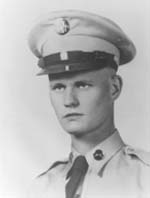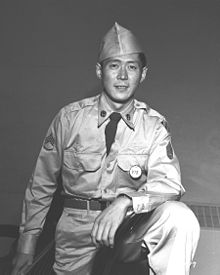1945 - For his brothers! When a 500-pound Japanese bomb blows up in the perimeter of Company A, 127th Infantry, 32nd Infantry Division, on the island of Luzon in the Philippines, 21-year-old Private First Class David M. Gonzales of Pacoima, California does not hesitate in crawling through enemy fire to dig out five men buried in the blast, even when he sees his commanding officer killed doing the same thing ... bullets flying everywhere, he frees one man, than exposing himself even more so he can dig faster, he stands up and digs out two more survivors ... trying for his 4th, his luck finally runs out and he is killed. His posthumous Congressional Medal of Honor will be presented to his family by President Harry S. Truman on December 8, 1945.

Gonzales
1945 - While on the other side of the world. Going up again and again over Italy's Po Valley in his P-47 Thunderbolt fighter/bomber, 22-year-old First Lieutenant Raymond Lee Knight of Texas embarks on two days of battles that find him flying low over a German airfield through enemy fire to discover hidden gun positions and aircraft (he finds 8 planes beneath camouflage netting), coming back down and destroying 5 planes (while the rest of his flight get two others), returning to base and volunteering to lead another flight to a different German base where he makes another low-level run that reveals more concealed planes (an entire squadron), then making 10 runs on the airfield, destroying six fully loaded enemy twin-engine planes and two fighters (his companions take out four other twin-engines and a fighter), while being hit by anti-aircraft fire three different times. The next morning he leads another four pilot flight back to the base that takes out three more twins and a fighter. His plane shot up, knowing his squadron is short on aircraft, instead of bailing out, Knight then decides to try to nurse his plane back to base in a plane too badly damaged for the task, and he goes down in the Appennines Mountains and is killed ... five months later, he will be awarded a posthumous Congressional Medal of Honor for his two days over Italy!
Knight
1967 - Part of a company pinned down by a North Vietnamese rifle company, 23-year-old Staff Sergeant Kenneth Edward Stumpf of Neenah, Wisconsin, runs through hostile fire three different times to rescue wounded comrades, then he leads a squad that takes out two enemy bunkers. When a third bunker opens fire, by himself he crosses an open field through enemy bullets, arrives at the bunker and throws a grenade in a gun opening ... a grenade which is immediately pitched back out at Stumpf ... so Stump pulls two more grenades, pulls their pins, and then holds on to them for two seconds so that they can't be returned, and throws them in the bunker, taking out another machine gun ... actions which win Stumpf the Congressional Medal of Honor.

Stumpf
1968 - After his commander is wounded, a day after his 21st birthday, Captain James Michael Sprayberry of La Grange, Georgia takes charge of his unit and leads a seven-and-a-half hour rescue of wounded men outside his lines, during which he kills 12 Vietnamese soldiers, destroys 2 machine guns, and knocks out a number of enemy-held bunkers, winning the Congressional Medal of Honor.

Sprayberry
1951 - Near Popsudong, Korea ... part of two squads maintaining defensive positions while his battalion withdraws from the area, 22-year-old U.S. Army Corporal John Essebagger, Jr. of Holland, Michigan helps repulse a number of enemy attacks, then voluntarily stays behind to provide cover fire while his own squad pulls back ... and launches a one man attack in which he fires into and throws grenades at the overwhelming numbers coming his way until he falls, mortally wounded, providing the time his squad needs to escape ... and winning a posthumous Congressional Medal of Honor.
Essebagger
1951 - Near Tongmang-ni, Korea ... positioned with his automatic rifle to protect a defile ledaing to his company's perimeter, 17-year-old U.S. Army Corporal Charles L. Gilliland of Mountain Home, Arkansas stays at his place alone, after his assistant is killed, beating back attack after attack ... when he notices to enemy soldiers infiltrate into the sector, he leaves his foxhole and takes out both soldiers, sustaining a head wound in the process ... when orders are received to fall back to new defensive positions, Gilliland volunteers to stay behind to keep the advancing enemy at bay ... a mission he accomplishes at the loss of his own life, winning a posthumous Congressional Medal of Honor.

Gilliland
1951 - Near Popsu-dong, Korea ... gunner of a three man machine gun position, 21-year-old U.S. Army Corporal Clair Goodblood of Fort Kent, Maine stays behind to cover his company's withdrawal from the area ... when a grenade comes into the position, Goodblood covers his assistant, but both men are wounded in the explosion, refusing medical assistance, Goodblood orders the uninjured ammunition bearer to evacuate his wounded assistant, and he stays behind to take on the next enemy attack, which sweeps over the hill he is holding ... when the ground is later retaken, Goodblood is found dead at his weapon, surrounded by over 100 equally dead enemy soldiers. For his heroic actions, Goodblood is awarded a posthumous Congressional Medal of Honor.
Goodblood
1951 - Near Taejon-ni, Korea ... 25-year-old U.S. Army Corporal Hiroshi Miyamura of Gallup, New Mexico in command of a machine gun squad, leaps out of his foxhole as his men are about to be overwhelmed, and blunts an attack by killing ten enemy soldiers with a bayonet, attends to the wounded and coordinates their evacuation, stops another assault using up all of his machine gun ammo, and stays behind, destroying the weapon as his men follow his orders and withdraw to another position, fights his way back to his men using his bayonet, and when his company is ordered out of the area, stays behind to cover the movement despite being wounded (50 bodies will later be found around his position ... captured, he is repatriated to the United States in 1953, where upon his return, he is awarded a Congressional Medal of Honor by President Eisenhower at the White House.

Miyamura
No comments:
Post a Comment